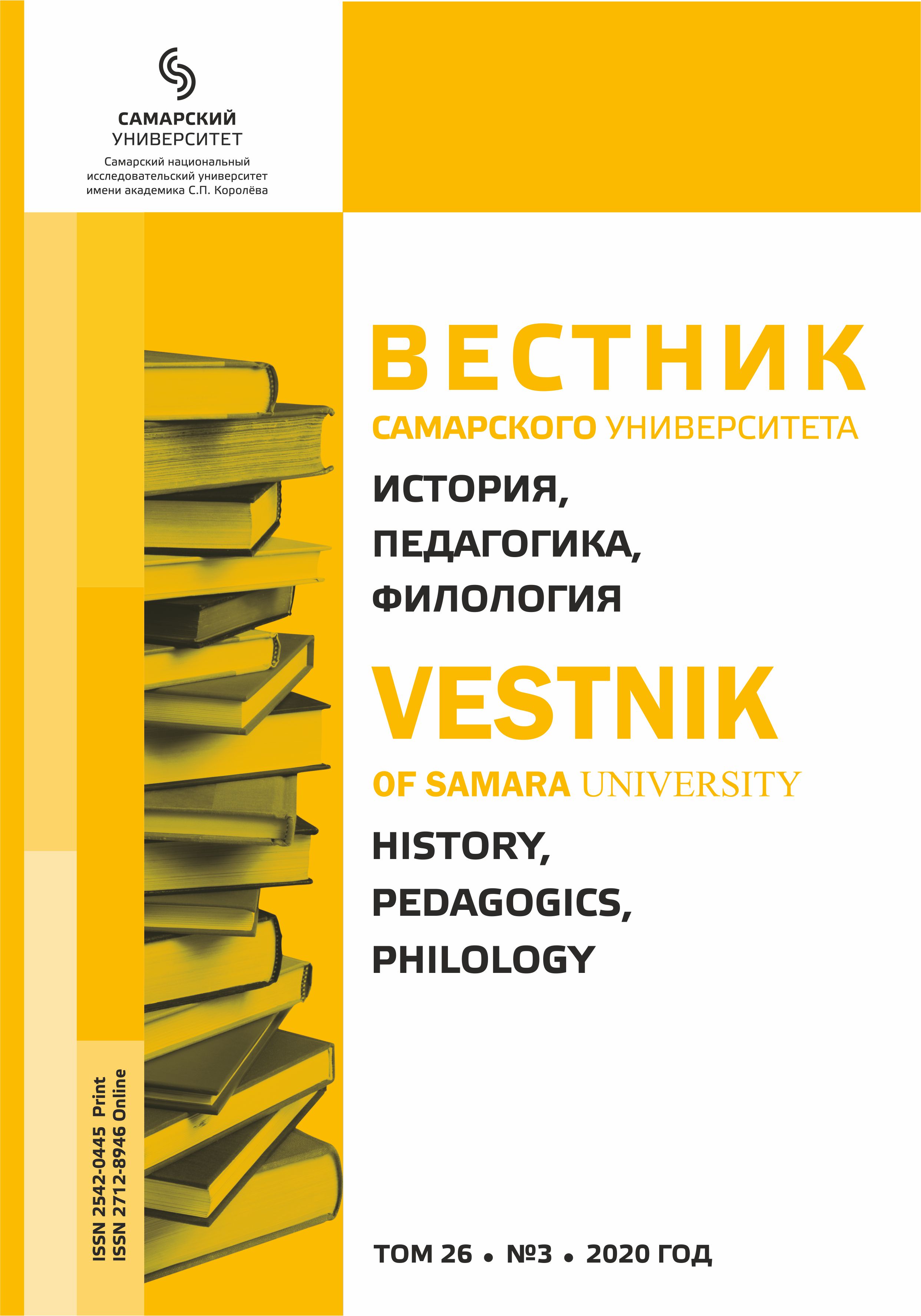Структурные особенности и специфика функционирования аббревиатур в профессиональном дискурсе (на примере лексики атомной отрасли)
- Авторы: Фельдман Н.Б.1,2
-
Учреждения:
- Владимирский государственный университет имени А.Г. и Н.Г. Столетовых, г. Владимир, Российская Федерация
- Информационный центр по атомной энергии Владимира, г. Владимир, Российская Федерация
- Выпуск: Том 26, № 3 (2020)
- Страницы: 121-130
- Раздел: Статьи
- URL: https://journals.ssau.ru/hpp/article/view/8196
- DOI: https://doi.org/10.18287/2542-0445-2020-26-3-121-130
- ID: 8196
Цитировать
Полный текст
Аннотация
В статье выделяются три основания классификации инициальных и смешанных аббревиатур, относящихся к лексике атомной отрасли: по лексико-грамматическому разряду (апеллятивы, номены, онимы), характеру произношения (алфабетизмы и акронимы) и происхождению (исконные и заимствованные аббревиатуры). Исследование типовых характеристик аббревиатур осуществляется с использованием описательного, контекстуального, прагматического и структурного методов анализа с целью выявления специфических особенностей, свойственных аббревиатурам, функционирующим в профессиональном дискурсе, на языковом материале, относящемся к лексике атомной отрасли. По результатам исследования были сделаны следующие выводы, фиксирующие общие и специфические характеристики аббревиатур в профессиональном дискурсе: 1) с коммуникативно-дискурсивной точки зрения процесс аббревиации обеспечивает успешность коммуникативного акта благодаря экономии объема высказывания, краткому и четкому выражению мысли; 2) в то же время использование аббревиатур вне профессионального дискурса может привести к коммуникативной неудаче из-за существующей дискурсивной антиномии «свой – чужой», определяющей носителей профессионального знания и людей, не включенных в соответствующий профессиональный дискурс; 3) преобладание аббревиатур-апеллятивов объясняется обилием многословных терминов, характерных для развивающейся отрасли и молодой терминологической системы; 4) специфическими особенностями аббревиатур-номенов можно назвать особую смысловую нагрузку их числовой либо буквенной части, мотивированную для профессионалов и неясную для остальных носителей языка; 5) аббревиатуры-онимы, включающие эргонимы и хрематонимы, образуются в соответствии с общеязыковыми тенденциями; 6) преобладание алфабетизмов над акронимами, нехарактерное для современного русского языка, вызвано обилием многословных терминов, зачастую образующих аббревиатуры с труднопроизносимыми сочетаниями звуков, а также стремлением сохранить информационную значимость компонентов и процессами омонимического отталкивания.
Об авторах
Н. Б. Фельдман
Владимирский государственный университет имени А.Г. и Н.Г. Столетовых,г. Владимир, Российская Федерация; Информационный центр по атомной энергии Владимира, г. Владимир, Российская Федерация
Автор, ответственный за переписку.
Email: morenov@ssau.ru
ORCID iD: 0000-0002-0354-3778
аспирант кафедры русского языка, Педагогический институт, Владимирский государственный университет имени А.Г. и Н.Г. Столетовых, 600000, Российская Федерация, г. Владимир, ул. Горького, 87; Информационный центр по атомной энергии Владимира
Список литературы
- Zorkina, Kostina, Pitina 2015 – Natalia Zerkina, Nikolaevna Kostina, Svetlana Anatol’evna Pitina. Abbreviation Semantics // Procedia – Social and Behavioral Sciences, August 2015, Vol. 199, Issue 1, pp. 137–142. doi: 10.1016/j.sbspro.2015.07.497.
- Annisette 2017 – Marcia Annisette. Discourse of the professions: The making, normalizing and taming of Ontario's «foreign-trained accountant» // Accounting, Organizations and Society, 2017, Vol. 60, pp. 37-61. doi: 10.1016/j.aos.2017.06.006.
- Koriche 2015 – Hassiba Koriche. The Emergence of a New Discourse for Business Communication, ‘A Case Study of e-mails in Shipping Company’ // Procedia – Social and Behavioral Sciences, 2015, Vol. 199, pp. 539–547. doi: 10.1016/j.sbspro.2015.07.544.
- Kuzmina, Fominykh, Abrosimova 2015 – Olga D. Kuzmina, Anna D. Fominykh, Natalia A. Abrosimova. Problems of the English Abbreviations in Medical Translation // Procedia – Social and Behavioral Sciences, 2015, Vol. 199, pp. 548–554. doi: 10.1016/j.sbspro.2015.07.545.
- Жаркова 2012 – Жаркова Т.И. Аббревиатура в межкультурной деловой коммуникации // Вестник Иркутского государственного лингвистического университета. 2012. № 2. C. 22–27. URL: https://cyberleninka.ru/article/n/abbreviatura-v-mezhkulturnoy-delovoy-kommunikatsii.
- Кухно 2016 – Кухно И.Ю. Коммуникативно-прагматический и когнитивный аспекты изучения термина // Вестник Самарского университета. История, педагогика, филология. 2016. № 2. С. 204-207. URL: https://journals.ssau.ru/index.php/hpp/article/view/4251.
- Лейчик 2009 – Лейчик В.М. Люди и слова: Как рождаются и живут слова в русском языке / отв. ред. Г.В. Степанов. Изд. 2-е, испр. и доп. Москва: Книжный дом «ЛИБРОКОМ», 2009. 216 с.
- Максименко 2017 – Максименко О.И. Новые тенденции аббревиации (на примере русского, английского и немецкого языков) // Вестник РУДН. Серия «Теория языка. Семиотика. Семантика». 2017. Т. 8, № 1. С. 174–181. doi: 10.22363/2313-2299-2017-8-1-174-181.
- Романова 2012 – Романова Л.Г. Семантический потенциал аббревиатур в политическом дискурсе // Вестник ИрГТУ. 2012. № 5 (64). С. 352–355. URL: https://elibrary.ru/item.asp?id=17749621.
- Суперанская 2009 – Суперанская А.В. Общая терминология: Вопросы теории / отв. ред. Т.Л. Канделаки. Изд. 5-е. Москва: Книжный дом «ЛИБРОКОМ», 2009. 248 с. URL: http://padabum.com/d.php?id=30658.
- Ходжагельдыев, Шурупова 2016 – Ходжагельдыев Б.Д., Шурупова О.С. Особенности заимствования английских аббревиатур // Филологические науки. Вопросы теории и практики. 2016. № 12 (66): в 4 ч. Ч. 1. C. 186–188. URL: https://www.gramota.net/materials/2/2016/12-1/55.html.
- Шумарин 2011 – Шумарин С.И. Лексикографическое представление семантических и деривационных процессов в сфере аббревиации // Проблемы истории, филологии, культуры. 2011. № 3 (33). С. 94–96. URL: https://elibrary.ru/item.asp?id=17072403.
- Человек и его дискурс – 4 2014 – Человек и его дискурс – 4: коллективная монография / отв. ред. М.Р. Желтухина; ВГСПУ; ИЯ РАН. Москва: ИЯРАН; Издательский центр «Азбуковник», 2014. 398 с. URL: https://elibrary.ru/item.asp?id=23856432.
- Юдина, Котлярова 2019 – Юдина Н.В., Котлярова О.В. Языковой портрет государственного служащего: региональный аспект: монография. Владимир: Владимирский филиал РАНХиГС, 2019. 208 с. URL: https://elibrary.ru/item.asp?id=37225140.
- Ярмашевич 2013 – Ярмашевич М.А. Структура и семантика аббревиатур // Известия Саратовского университета. Новая серия. Серия Филология. Журналистика. 2013. Т. 13, Вып. 3. С. 3–5. URL: https://elibrary.ru/item.asp?id=25368997.
- Ярмашевич 2019 – Ярмашевич М.А. Структурные характеристики русских графо-лексических аббревиатур // Известия Саратовского университета. Новая серия. Серия Филология. Журналистика. 2019. Т. 19, Вып. 3. С. 261–267. doi: 10.18500/1817-7115-2019-19-3-261-267.
Дополнительные файлы













